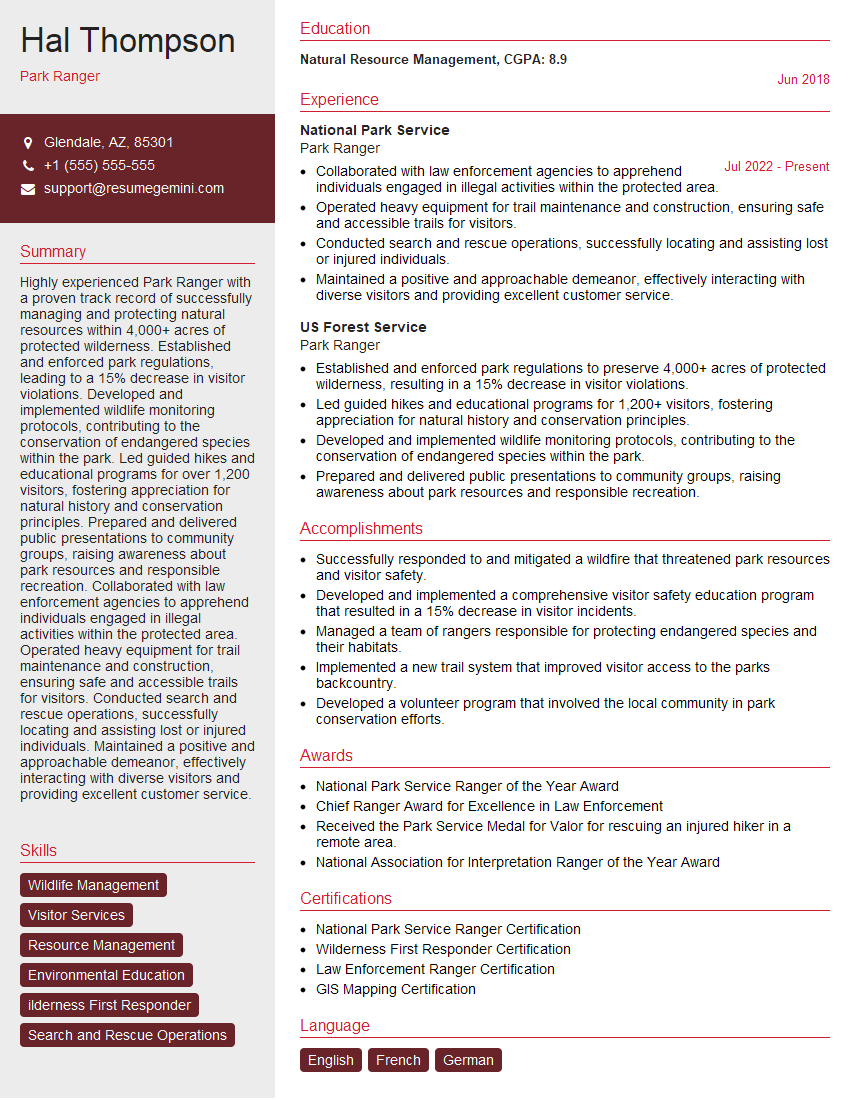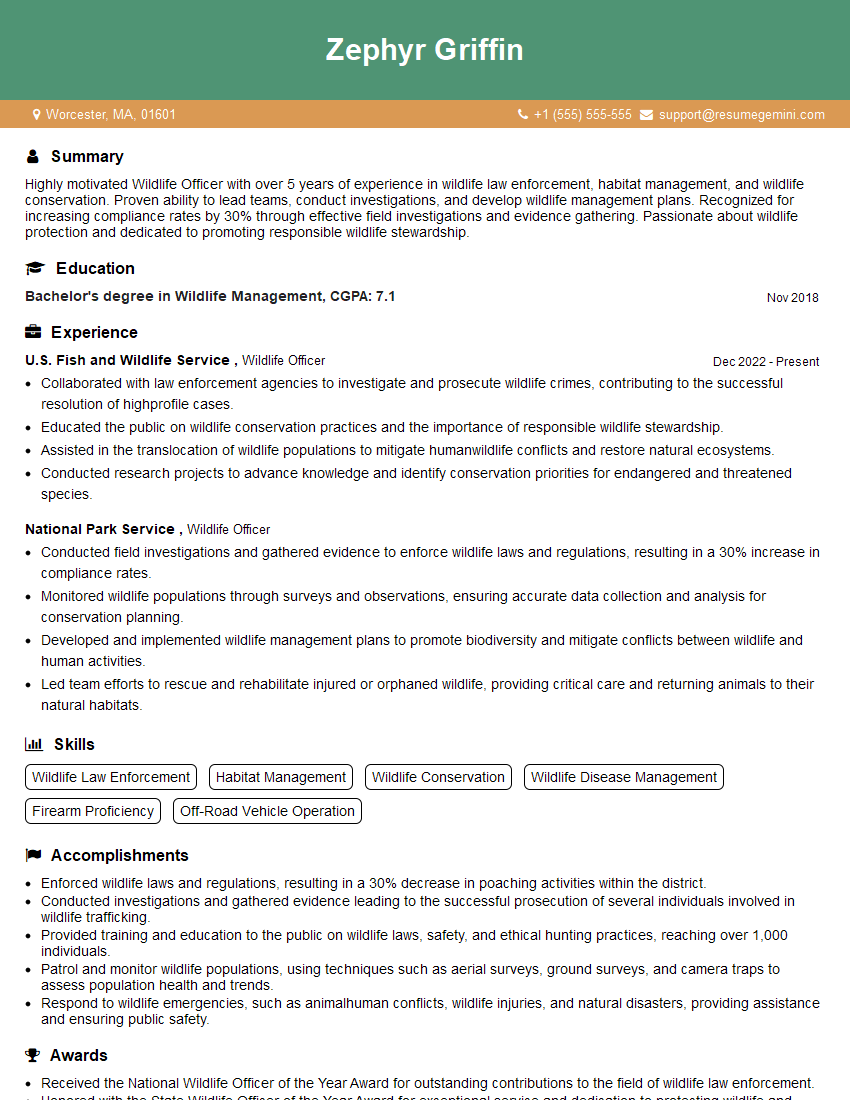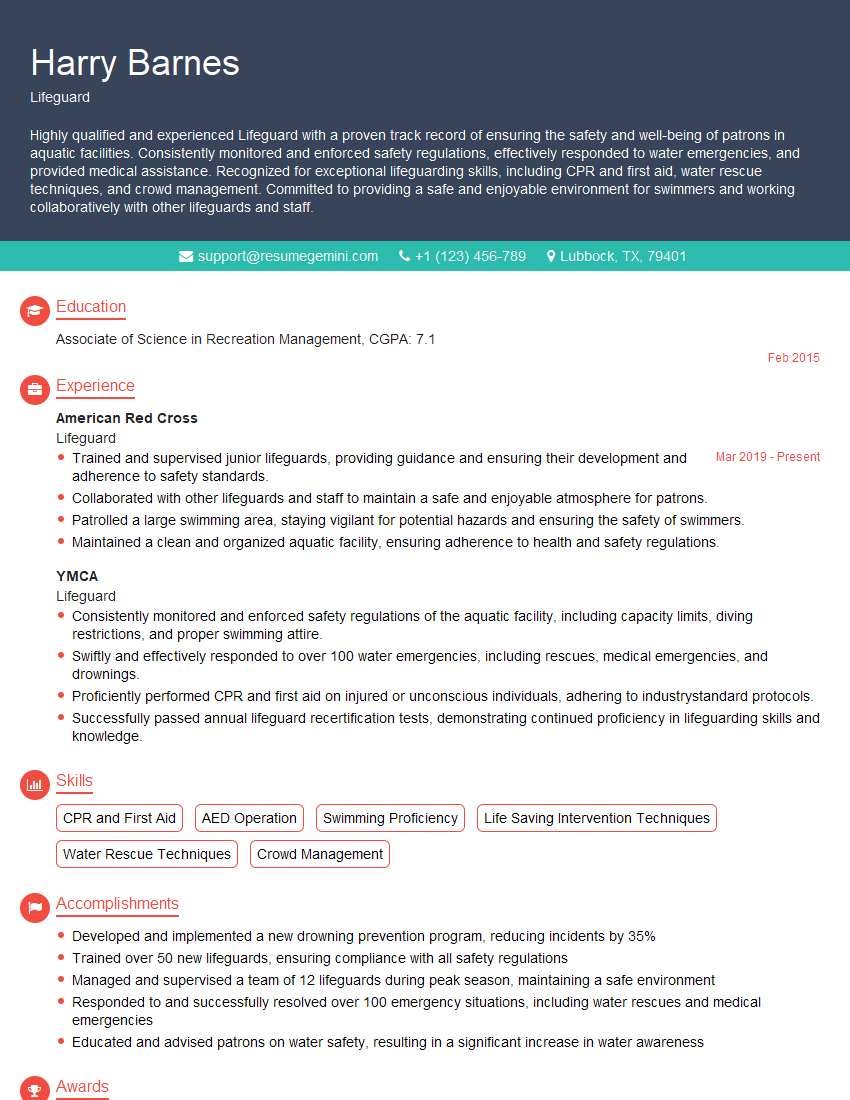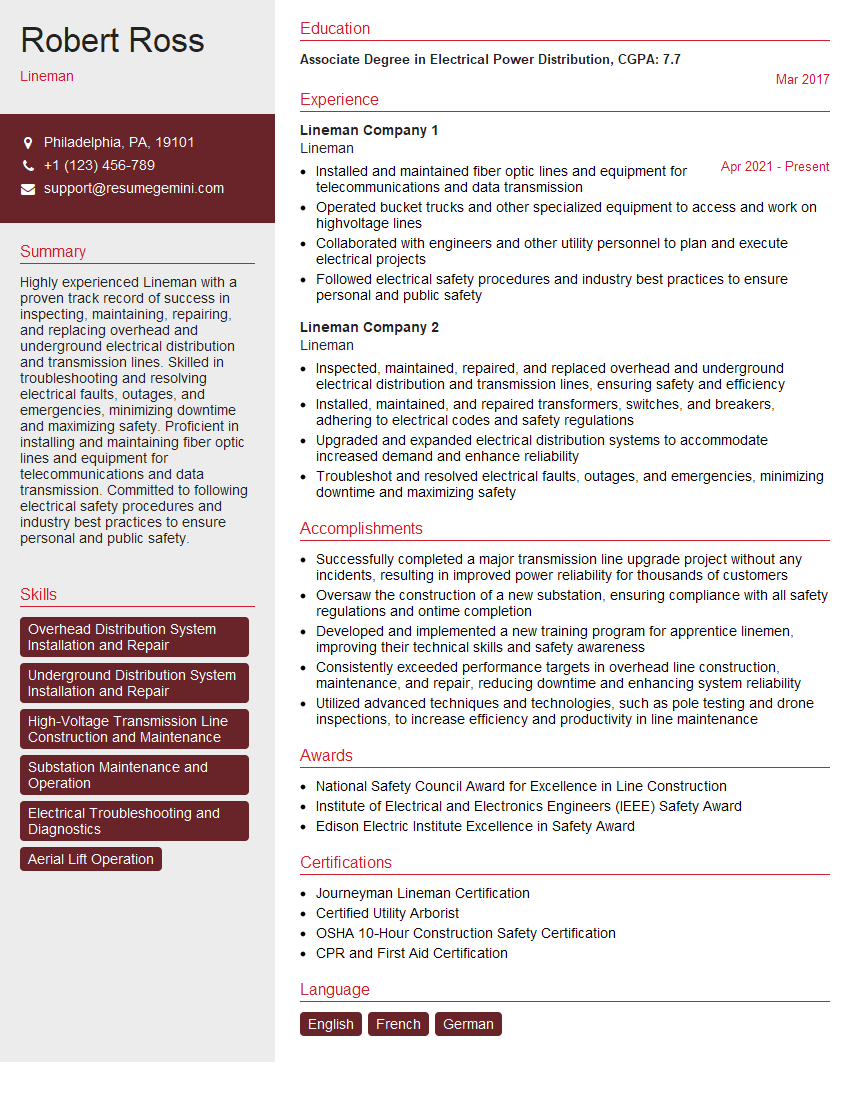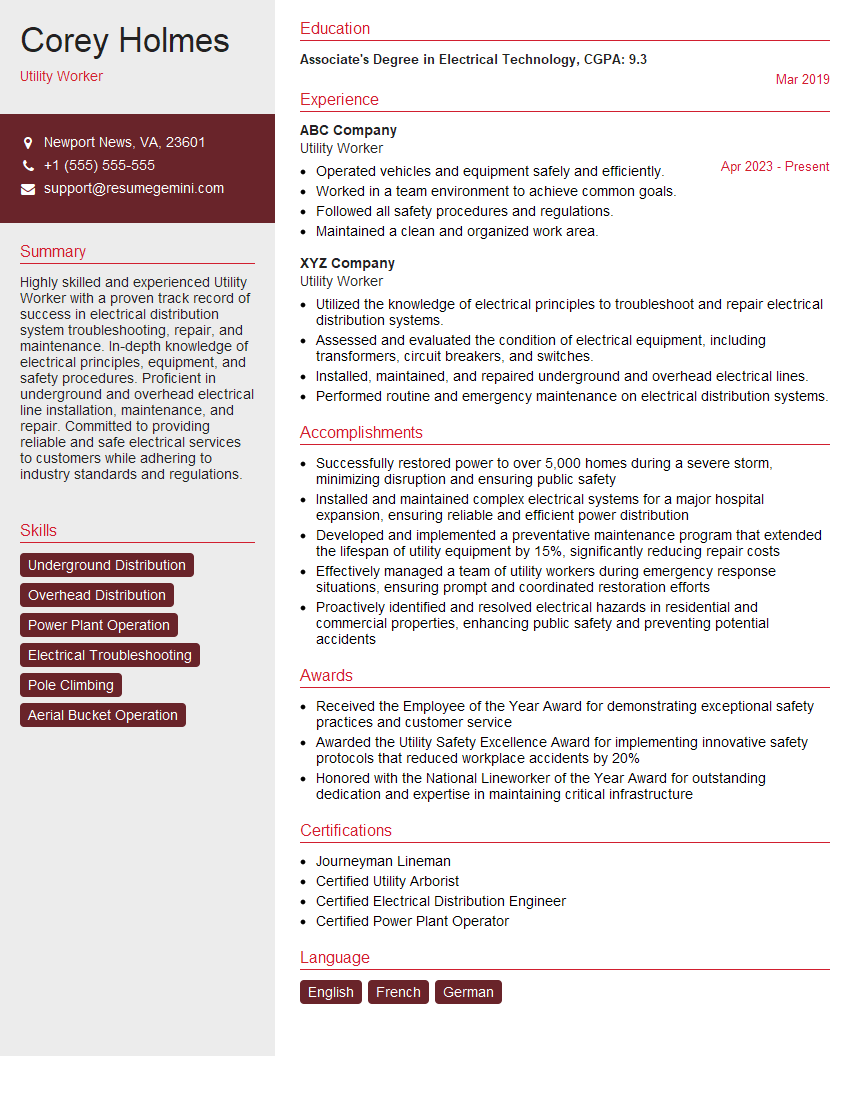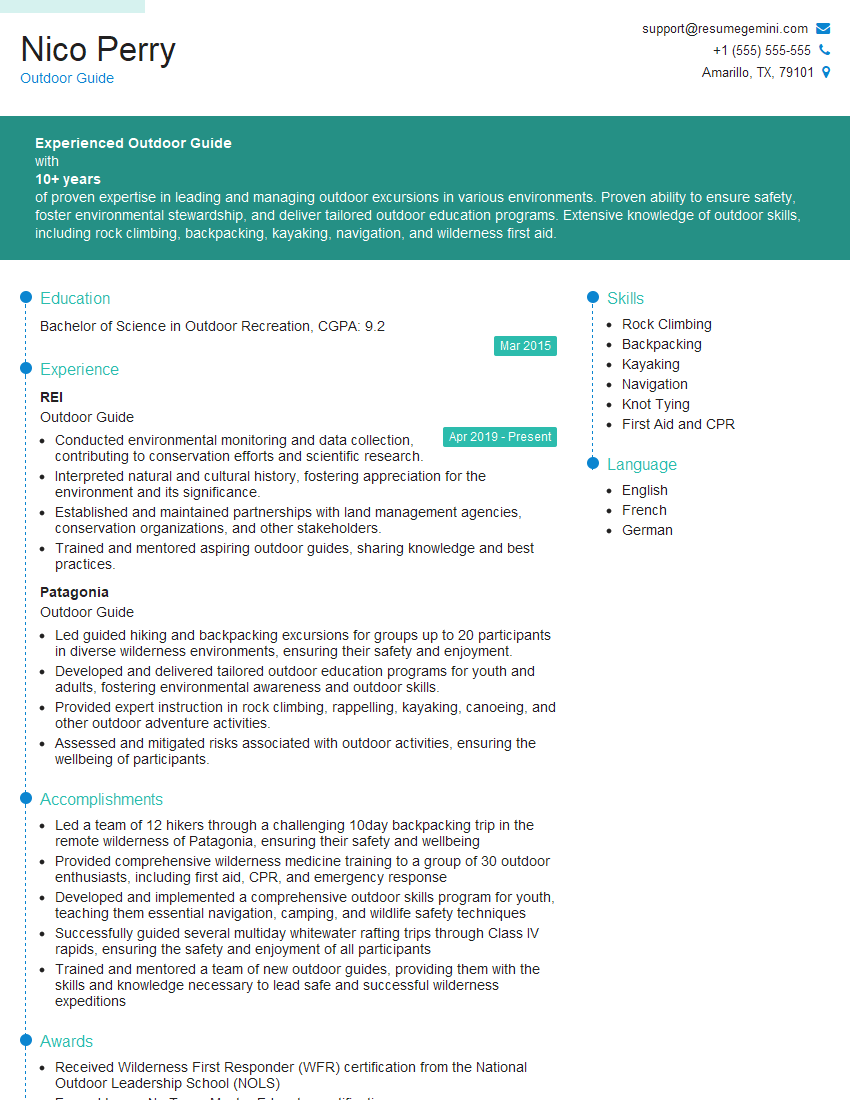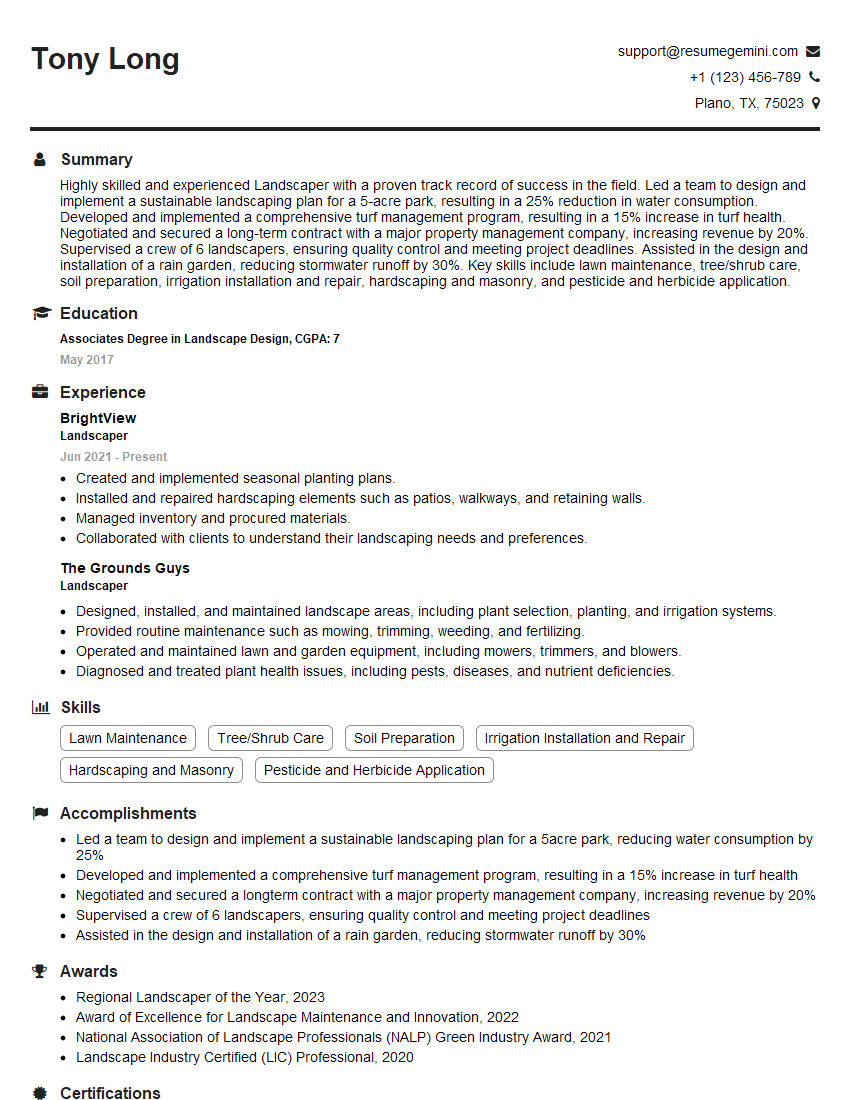The thought of an interview can be nerve-wracking, but the right preparation can make all the difference. Explore this comprehensive guide to Physical Endurance and Ability to Work in Challenging Conditions interview questions and gain the confidence you need to showcase your abilities and secure the role.
Questions Asked in Physical Endurance and Ability to Work in Challenging Conditions Interview
Q 1. Describe your experience managing physical exertion over prolonged periods.
Managing prolonged physical exertion requires a holistic approach encompassing strategic pacing, proper hydration and nutrition, and a keen awareness of one’s physical limits. It’s not just about pushing through; it’s about sustainable performance.
For instance, during a long-distance hike, I wouldn’t sprint the initial miles. Instead, I’d maintain a consistent, comfortable pace, taking regular breaks for water and light snacks. This prevents early fatigue and allows for consistent energy output over the entire duration. I’ve also learned to recognize early warning signs of overexertion – things like muscle cramps, excessive sweating, or dizziness – and to respond proactively by slowing down, resting, or adjusting my strategy. In a professional context, managing physical exertion might involve strategically scheduling demanding tasks throughout the day to avoid burnout.
Q 2. Explain your strategies for maintaining physical fitness and stamina.
Maintaining physical fitness and stamina is a continuous process that involves several key strategies: a balanced exercise program, a nutritious diet, and sufficient rest. My training regimen includes a mix of cardiovascular exercises like running and swimming, strength training to build muscle endurance, and flexibility exercises like yoga to prevent injury. I focus on progressive overload – gradually increasing the intensity and duration of my workouts over time – to challenge my body and improve my performance sustainably. My diet emphasizes complex carbohydrates for sustained energy, lean protein for muscle repair, and plenty of fruits and vegetables for essential nutrients. Finally, getting adequate sleep is crucial; it’s during sleep that my body repairs and rebuilds itself.
Q 3. How do you adapt your work practices to challenging environmental conditions (e.g., extreme heat, cold, or terrain)?
Adapting to challenging environmental conditions necessitates understanding the specific hazards and implementing appropriate mitigation strategies. In extreme heat, this could involve adjusting work schedules to avoid peak sun hours, utilizing cooling vests, or taking frequent hydration breaks. In extreme cold, layering clothing to trap warm air is crucial, along with regular movement to maintain body temperature. When working on challenging terrain, I emphasize proper footwear and using appropriate safety equipment like harnesses and ropes when necessary. I also adjust my work pace to match the conditions, acknowledging that tasks will take longer and require more energy in adverse environments. Prioritizing safety is paramount; if conditions become dangerously hazardous, work should be stopped until conditions improve.
Q 4. Describe a time you had to work under intense pressure or demanding physical conditions. What was the outcome?
During a search and rescue operation in a mountainous region, we faced several days of relentless work in freezing temperatures and challenging terrain. We were under intense pressure to locate a missing hiker before nightfall, leading to high physical and mental strain. We prioritized teamwork and maintained regular communication to monitor each other’s physical and mental state. We adjusted our search patterns based on the evolving conditions and employed all available resources efficiently. Despite the challenging conditions, we successfully located the hiker, demonstrating the importance of teamwork, adaptability, and meticulous planning under duress.
Q 5. How do you prioritize safety when working in physically demanding and potentially hazardous environments?
Prioritizing safety in physically demanding and hazardous environments is non-negotiable. This involves a multi-faceted approach: thorough risk assessment prior to commencing any task, adherence to all relevant safety protocols and regulations, proper use of personal protective equipment (PPE), and continuous monitoring of the work environment for potential hazards. Effective communication with team members is also critical to ensure everyone is aware of potential risks and to facilitate prompt response to emergencies. I never hesitate to stop work if safety is compromised, and I always advocate for the implementation of preventative measures.
Q 6. What measures do you take to prevent injuries while performing physically strenuous tasks?
Preventing injuries involves a combination of proactive measures and mindful practices. Proper warm-up and cool-down routines are essential to prepare the muscles for exertion and to promote recovery. Maintaining correct posture and body mechanics while performing tasks minimizes strain on joints and muscles. Using appropriate equipment and tools tailored to the task reduces the risk of accidental injuries. Regular stretching and flexibility exercises help improve range of motion and reduce muscle stiffness, thus decreasing the chances of injury. And finally, knowing one’s physical limits and taking breaks when needed prevents overexertion and fatigue-related injuries.
Q 7. How do you manage fatigue and maintain focus during long shifts or physically demanding work?
Managing fatigue during long shifts or physically demanding work involves a combination of strategic planning, self-awareness, and recovery techniques. Strategic breaks throughout the workday are crucial to allow for rest and replenishment. Staying hydrated and consuming nutritious snacks can help maintain energy levels. Mindfulness and focus techniques, such as deep breathing exercises, can help manage mental fatigue. Finally, ensuring adequate sleep and rest outside of work hours is paramount to overall physical and mental recovery. Ignoring fatigue can lead to errors and increase the risk of accidents; proactive management is key.
Q 8. Explain your understanding of proper hydration and nutrition for optimal physical performance.
Proper hydration and nutrition are fundamental for optimal physical performance. Think of your body like a high-performance engine; it needs the right fuel and fluids to operate efficiently. Dehydration, even mild, significantly impacts strength, endurance, and cognitive function. Similarly, inadequate nutrition leads to energy deficits and impaired recovery.
- Hydration: I prioritize consistent hydration throughout the day, not just during intense activity. This involves drinking water regularly, even before feeling thirsty. Electrolyte drinks are beneficial during prolonged exertion to replace salts lost through sweat. The amount of fluid needed depends on factors like climate, activity intensity, and individual sweat rate. I often use a hydration tracker to monitor my intake.
- Nutrition: A balanced diet rich in complex carbohydrates, lean protein, and healthy fats is crucial. Carbohydrates provide the primary energy source, protein supports muscle repair and growth, and fats provide sustained energy and support hormone production. Timing of meals is also important; consuming carbohydrates before and during prolonged activity provides sustained energy. Post-activity, protein and carbohydrates help with muscle recovery. I meticulously plan my meals and snacks to optimize energy levels and recovery.
For example, during a long hiking expedition, I would meticulously plan my hydration strategy, carrying enough water and electrolyte tablets. My food choices would prioritize high-energy foods like trail mix, energy bars, and dried fruit to sustain my energy levels throughout the day.
Q 9. How do you assess the risks associated with physically demanding tasks and develop mitigation strategies?
Assessing risks in physically demanding tasks involves a systematic approach. I start by identifying potential hazards through job hazard analysis (JHA) or similar risk assessments. This includes analyzing environmental factors (e.g., extreme temperatures, uneven terrain), task demands (e.g., repetitive movements, heavy lifting), and the use of equipment. After identifying hazards, I evaluate the likelihood and severity of potential injuries or incidents using a risk matrix. This helps prioritize mitigation strategies.
Mitigation strategies are developed based on the identified risks. These can include engineering controls (e.g., modifying equipment to reduce strain), administrative controls (e.g., implementing work-rest schedules), and personal protective equipment (PPE). For instance, if heavy lifting is involved, I’d ensure proper lifting techniques are used, and potentially incorporate mechanical lifting aids. If working in extreme heat, I’d implement frequent breaks in shaded areas and encourage hydration. Regular training and supervision are crucial to ensure the effectiveness of mitigation strategies.
For example, when planning a rescue operation in a mountainous region, I’d assess risks like altitude sickness, weather changes, and terrain difficulties. Mitigation strategies would include pre-acclimatization training for team members, carrying appropriate equipment for altitude sickness, and establishing clear communication protocols. Regular check-ins and contingency plans are also essential aspects of risk mitigation.
Q 10. Describe your experience working in a physically demanding environment where teamwork was crucial.
During a wildfire suppression effort, teamwork was absolutely essential. We worked in extreme heat and challenging terrain, battling unpredictable fire behaviour. My role involved operating heavy machinery to create firebreaks. The success of our efforts depended entirely on clear communication, coordinated actions, and mutual support amongst the team members. We had regular briefings to plan our actions and adjust strategies based on changing conditions. Trust and mutual respect within the team was paramount, ensuring efficiency and safety.
One particularly challenging scenario involved a sudden change in wind direction which threatened to overwhelm our position. Teamwork played a critical role in quickly adapting our strategy. One team used a specialized bulldozer to create a more effective barrier while the rest focused on containing the spread of flames using hand tools and water. Open communication and rapid response were critical to success, ensuring the safety of the team and the surrounding area.
Q 11. How do you adapt your physical approach to different types of challenging conditions?
Adapting to different challenging conditions requires a multifaceted approach that prioritizes both physical and mental resilience. My approach involves understanding the specific challenges posed by the environment and adjusting my strategies accordingly. This involves analyzing factors like temperature, terrain, altitude, and potential hazards.
- Temperature: In extreme heat, I focus on hydration, appropriate clothing, and frequent rest breaks. In cold conditions, I prioritize layering clothing, protecting exposed skin, and staying aware of signs of hypothermia.
- Terrain: Navigating challenging terrain requires proper footwear and knowledge of appropriate techniques, such as hiking strategies or using specialized equipment for climbing or traversing.
- Altitude: At higher altitudes, acclimatization is key, and I would adjust my pace and workload accordingly, staying aware of altitude sickness symptoms.
- Hazards: Identifying and mitigating potential hazards, such as wildlife encounters or unstable terrain, is always a priority. I carefully assess risks and adjust my strategies as needed.
For example, when transitioning from a desert environment to a high-altitude environment, I would adjust my pacing significantly, increase my hydration intake, and pay close attention to altitude sickness symptoms. My clothing choices would also change dramatically to address the differences in temperature and weather conditions.
Q 12. Have you ever had to modify a physical task due to unforeseen circumstances? Describe the situation and your solution.
During a bridge repair project, unexpected flooding occurred due to heavy rainfall. The initial plan involved using standard lifting equipment to replace damaged sections of the bridge. However, the flooding made the area inaccessible to the heavy machinery. I had to quickly adapt the plan. We switched to a smaller, more maneuverable crane which allowed us to replace the damaged sections without compromising the safety of the workers. Effective communication and quick decision-making prevented further delays and ensured the project’s completion despite unforeseen challenges.
Q 13. How do you handle unexpected physical demands during a typical workday?
Handling unexpected physical demands during a workday requires a combination of preparation, adaptability, and prioritization. I always maintain a level of physical fitness to handle unexpected exertion. My approach involves pacing myself, prioritizing tasks based on urgency and physical demands, and knowing my limits. If a particularly strenuous task arises, I will break it down into smaller, more manageable segments, incorporating regular rest periods to prevent fatigue and injury. If the unexpected demand is beyond my capabilities or poses a safety risk, I immediately inform my supervisor and seek assistance.
Q 14. What is your experience with using personal protective equipment (PPE) in physically challenging situations?
My experience with PPE is extensive and crucial for safety in physically challenging situations. I am proficient in the use and maintenance of various types of PPE, including hard hats, safety glasses, gloves, high-visibility clothing, and respiratory protection. The selection of PPE depends entirely on the specific hazards present. For instance, when working with heavy machinery, I always use appropriate eye and hearing protection. In environments with airborne hazards, I would use respirators. Proper fit and regular inspection of PPE are paramount to ensure its effectiveness.
Training on the proper use and limitations of PPE is essential. I understand that PPE is only one layer of protection and that safe work practices are just as important, if not more so. For example, even with a respirator, maintaining appropriate ventilation is crucial to prevent hazardous buildup of airborne contaminants.
Q 15. How do you maintain situational awareness in physically demanding and potentially hazardous environments?
Maintaining situational awareness in demanding environments is crucial for safety and efficiency. It’s about constantly scanning your surroundings, assessing potential risks, and anticipating changes. This involves a multi-sensory approach.
- Visual scanning: Regularly scan your environment, looking for obstacles, hazards, changes in terrain, and the actions of others.
- Auditory awareness: Listen for warning signals, changes in soundscapes (e.g., approaching machinery, shifting terrain), and communication from colleagues.
- Kinesthetic awareness: Pay close attention to your body’s feedback – fatigue, discomfort, and changes in balance. This helps anticipate potential slips, trips, or falls.
- Cognitive processing: Continuously integrate the information from your senses to build a mental picture of the situation. This includes anticipating potential problems and planning accordingly.
For example, while working on a mountain rescue operation, I consistently scanned the terrain for loose rocks, listened for changes in weather patterns (wind shifts, approaching storms), and monitored my own energy levels to ensure I could perform efficiently without compromising safety.
Career Expert Tips:
- Ace those interviews! Prepare effectively by reviewing the Top 50 Most Common Interview Questions on ResumeGemini.
- Navigate your job search with confidence! Explore a wide range of Career Tips on ResumeGemini. Learn about common challenges and recommendations to overcome them.
- Craft the perfect resume! Master the Art of Resume Writing with ResumeGemini’s guide. Showcase your unique qualifications and achievements effectively.
- Don’t miss out on holiday savings! Build your dream resume with ResumeGemini’s ATS optimized templates.
Q 16. Describe your experience with injury prevention and recovery.
Injury prevention is paramount. My approach is proactive and multi-faceted. It begins with proper training and conditioning, ensuring I’m physically prepared for the demands of the job. This includes regular strength training, cardiovascular exercise, and flexibility work.
- Proper warm-up and cool-down: Essential to prepare muscles and prevent injury.
- Correct lifting techniques: Using proper posture and body mechanics to minimize strain.
- Use of appropriate safety equipment: Always wearing the necessary PPE (Personal Protective Equipment) like harnesses, helmets, and appropriate footwear.
- Understanding physical limitations: Recognizing personal limitations and avoiding overexertion. Rest is key to prevent fatigue and injury.
In case of injury, my approach prioritizes immediate first aid, followed by seeking appropriate medical attention. Recovery involves rest, physical therapy, and a gradual return to activity, following medical advice. I’ve had experience recovering from a minor ankle sprain, adhering strictly to the recommended physiotherapy regime and gradually increasing my activity levels to avoid re-injury.
Q 17. How do you respond to a colleague suffering a physical injury or illness on the job?
Responding to a colleague’s injury requires immediate action and prioritization of their well-being. My response follows a structured approach:
- Assess the situation: Determine the nature and severity of the injury.
- Provide immediate first aid: Administer basic first aid if trained and appropriate, while prioritizing the victim’s safety and comfort.
- Call for emergency assistance: Contact emergency medical services or a supervisor as needed.
- Keep the victim calm and comfortable: Provide reassurance and support.
- Document the incident: Record details of the incident for future reporting and analysis.
In a past incident where a colleague suffered a heat stroke, I immediately moved him to a shaded area, provided water and electrolytes, and contacted emergency services. While waiting for help, I monitored his vital signs and kept him comfortable.
Q 18. What are some common physical hazards you’ve encountered, and how did you mitigate them?
Throughout my career, I’ve encountered various physical hazards, including:
- Extreme weather conditions: Heat, cold, wind, and precipitation. Mitigation involves proper clothing, hydration, and understanding weather forecasts.
- Uneven terrain: Rough ground, steep inclines, and slippery surfaces. Mitigation includes appropriate footwear, use of safety harnesses, and careful movement.
- Exposure to hazardous materials: Chemicals, biological agents, and other potentially harmful substances. Mitigation includes the use of appropriate PPE (e.g., respirators, gloves, protective clothing), and adherence to safety protocols.
- Working at heights: Requires harnesses, ropes, and adherence to safety procedures.
For instance, during a search and rescue mission in a blizzard, we utilized specialized cold-weather gear, and practiced safe rope techniques to navigate hazardous ice formations. Regular communication within the team ensured everyone’s safety.
Q 19. How do you stay motivated and focused when faced with prolonged physical challenges?
Maintaining motivation and focus during prolonged physical challenges relies on a combination of mental strategies and physical preparation.
- Setting achievable goals: Breaking down large tasks into smaller, manageable ones provides a sense of accomplishment and keeps motivation high.
- Positive self-talk: Encouraging oneself and focusing on progress rather than setbacks.
- Visualization: Mentally rehearsing successful completion of the task enhances mental resilience.
- Teamwork and support: Sharing challenges and successes with teammates fosters a sense of community and mutual encouragement.
- Proper nutrition and rest: Adequate rest and balanced nutrition fuel the body and mind.
During an ultra-marathon, I regularly used visualization techniques to overcome fatigue and setbacks. Breaking down the course into smaller segments and celebrating each milestone helped maintain my focus.
Q 20. Describe your ability to work effectively both independently and as part of a team in demanding conditions.
I excel in both independent and collaborative work settings in demanding conditions. In independent work, I am self-reliant, resourceful, and capable of making sound judgments under pressure. I possess strong problem-solving skills and can adapt to changing circumstances effectively.
When working as part of a team, I prioritize effective communication, collaboration, and mutual support. I actively contribute to team discussions, share my expertise, and readily assist my colleagues. I’m adept at coordinating actions with team members, ensuring everyone is aware of the plan and their roles. A successful wildfire suppression operation, where clear communication and coordinated efforts among team members were crucial for success, exemplifies this ability.
Q 21. What is your preferred method for staying hydrated and fueled during prolonged exertion?
Staying hydrated and fueled during prolonged exertion is crucial for performance and safety. My strategy involves a combination of proactive planning and consistent monitoring.
- Hydration: I begin hydrating several hours before exertion and continue regularly throughout. I prefer water or sports drinks with electrolytes depending on the intensity and duration of activity. I avoid sugary drinks as they can lead to crashes in energy levels.
- Fueling: I consume easily digestible carbohydrates before, during, and after prolonged exertion. This includes energy gels, bars, and fruit, depending on the activity and personal preference. I also ensure I have a balanced diet in the days leading up to any significant physical activity.
- Monitoring: I regularly monitor my hydration and energy levels and adjust my intake accordingly. Signs of dehydration or low energy prompt me to increase fluid and food intake.
During a multi-day expedition, I planned my meals meticulously, ensuring a balance of carbohydrates, proteins, and fats. I carried a hydration pack and regularly replenished my fluids and energy stores.
Q 22. Describe your experience managing your body’s stress response to prolonged physical strain.
Managing my body’s stress response during prolonged physical strain involves a multi-faceted approach focusing on proactive measures and mindful adaptation. It’s essentially about training my body and mind to work together efficiently under pressure.
Proper Nutrition and Hydration: Fueling my body with nutrient-rich foods and staying consistently hydrated are paramount. Think of it like keeping a high-performance engine well-oiled. Dehydration and poor nutrition significantly hamper performance and increase stress.
Controlled Breathing Techniques: Deep, controlled breathing helps regulate my heart rate and reduces the production of stress hormones like cortisol. I practice diaphragmatic breathing exercises regularly, especially before, during, and after strenuous activity. This is like having a built-in calming mechanism.
Progressive Overload and Training: Gradual increases in training intensity and duration allow my body to adapt and build resilience to stress. It’s not about suddenly pushing my limits, but steadily building my capacity. Think of it as building muscle memory – for endurance.
Rest and Recovery: Sufficient sleep, rest periods during activities, and planned downtime are essential for muscle repair and stress recovery. Ignoring this is like expecting a car to run forever without maintenance.
Mental Fortitude: Developing mental resilience is key. Positive self-talk, visualization, and focusing on the task at hand help me overcome mental fatigue and push through physical challenges. It’s all about the mind-muscle connection.
Q 23. How do you monitor your own physical limits and avoid overexertion?
Monitoring my physical limits involves a combination of self-awareness, objective data, and a proactive approach to prevent overexertion. It’s crucial to listen to your body and interpret the signals it sends.
Rate of Perceived Exertion (RPE): I use the RPE scale, which subjectively assesses how hard my body feels it’s working. This allows me to gauge effort independent of heart rate monitors. It’s like having an internal barometer.
Heart Rate Monitoring: I use a heart rate monitor to track my cardiovascular response. Knowing my maximum heart rate and training zones helps me understand when I’m pushing too hard.
Regular Check-ins and Breaks: I incorporate regular self-assessments throughout physical tasks. Taking short breaks to rehydrate, refuel, and allow my body to recover prevents fatigue build-up. Think of it as scheduled maintenance.
Progressive Overload Principle: I consistently apply this principle, gradually increasing the intensity or duration of my physical activity, ensuring my body has adequate time to adapt and prevent injury. Gradual increase, rather than sudden sprints.
Q 24. What are some indicators that you are approaching your physical limits, and how do you respond?
Several indicators signal I’m approaching my physical limits. Recognizing these early is critical for preventing injury and burnout.
Muscle Fatigue: Experiencing significant muscle weakness or soreness is a clear sign. It’s like your muscles screaming ‘stop!’
Elevated Heart Rate and Breathing Rate: A significantly higher heart rate and rapid, shallow breathing indicate increased cardiovascular stress. The body is working harder than it can sustain.
Decreased Performance: If my pace slows noticeably, my technique deteriorates, or I start making more mistakes, it’s a sign my body is nearing its limit. It’s a performance dip.
Mental Fatigue: Difficulty focusing, increased irritability, or feelings of overwhelming tiredness show mental and physical fatigue are intertwined.
Pain: Pain is a significant warning sign. While some muscle soreness is normal, sharp, intense pain requires immediate attention and rest. This is your body’s alarm system.
My response to these indicators always prioritizes safety. I immediately reduce the intensity or duration of the activity, take breaks, and rehydrate. If pain persists, I seek medical attention.
Q 25. How do you prioritize tasks and manage your workload when physical demands are high?
Prioritizing tasks and managing workload under high physical demands requires a strategic approach. I combine planning, execution, and self-awareness.
Task Prioritization: I employ methods like the Eisenhower Matrix (urgent/important) to classify tasks. This ensures I focus on the most critical activities first, maximizing efficiency.
Time Management: I break down large tasks into smaller, manageable chunks. This prevents feeling overwhelmed and allows for regular rest periods.
Pacing: I avoid starting at maximum intensity. I adopt a sustainable pace to prevent early exhaustion, allowing consistent effort over longer periods.
Delegation: When possible, I delegate tasks to others to distribute the physical load. Teamwork is crucial in such situations.
Rest and Recovery Scheduling: I strategically plan breaks and rest periods into my schedule to prevent burnout. This is not just downtime; it’s essential for performance.
Q 26. Describe your understanding of the principles of ergonomics and its application to your work.
Ergonomics is the science of designing workplaces and tasks to suit the human body, minimizing physical strain and promoting safety. It’s about optimizing the fit between people and their work environment.
Proper Posture and Body Mechanics: Maintaining good posture reduces strain on my back, neck, and shoulders. Proper lifting techniques prevent injuries. It’s all about aligning your body to the task.
Tool Selection and Usage: I choose and use tools correctly. Poor tool design or improper use can exacerbate physical stress. The right tools for the job are paramount.
Workstation Setup: I ensure my workstation is properly configured – chair height, keyboard position, monitor placement – to minimize strain. Think of it as creating a supportive ecosystem for your body.
Environmental Factors: I consider factors like temperature, lighting, and noise, ensuring they don’t negatively impact my performance and safety. A supportive environment is as vital as the tools and tasks.
Regular Breaks and Movement: I integrate regular breaks and movement to prevent prolonged static postures. Micro-breaks throughout the day maintain blood circulation and reduce stress.
Q 27. How do you adapt your communication style to ensure effective teamwork under physically challenging conditions?
Effective communication under physically challenging conditions requires clear, concise, and adaptable communication styles. The goal is to maintain situational awareness and teamwork.
Clear and Concise Language: I use simple, direct language, avoiding jargon. The priority is understanding, not eloquent speech.
Non-Verbal Communication: I pay attention to body language and use gestures to convey information, particularly when noise levels are high. Body language can be more effective than words in stressful environments.
Regular Check-ins: I frequently check in with team members to assess their physical and mental state and address any concerns. It’s like a pulse check for the team.
Active Listening: I prioritize listening to my team, ensuring I understand their perspectives and concerns before responding. This fosters collaboration.
Adaptability: I adapt my communication methods based on the situation. If physical exertion limits verbal communication, I might use hand signals or written notes. Flexibility is key in challenging environments.
Q 28. Describe a time you successfully overcame a significant physical challenge. What did you learn?
During a long-distance wilderness expedition, I encountered unexpectedly harsh weather conditions. The extreme cold, coupled with carrying heavy gear, tested my physical and mental limits.
I had to adapt my strategy, taking more frequent, shorter breaks to avoid hypothermia. I paced myself to conserve energy and focus on maintaining a positive attitude. We successfully completed the expedition, proving the importance of teamwork, adaptability, and mental fortitude in overcoming significant physical challenges.
My key learning was that exceeding physical limits isn’t solely about physical strength, it’s deeply rooted in smart planning, resource management, and a resilient mindset. It demonstrated the power of preparation and the critical interplay between physical and mental strength in enduring extreme challenges.
Key Topics to Learn for Physical Endurance and Ability to Work in Challenging Conditions Interview
- Understanding Physical Endurance: Defining and assessing your own physical capabilities, including cardiovascular fitness, muscular strength and endurance, and flexibility. Consider how different work environments may demand varying levels of each.
- Adapting to Challenging Conditions: Discussing your experience working in demanding environments (heat, cold, altitude, uneven terrain, etc.). Highlight specific instances where you demonstrated resilience and problem-solving skills in such conditions.
- Safety and Risk Mitigation: Demonstrating knowledge of safety protocols and procedures relevant to your field. Explain your approach to identifying and mitigating potential risks in challenging situations.
- Maintaining Performance Under Pressure: Explain strategies you use to manage fatigue, stress, and maintain focus during prolonged or intense physical activity. Provide examples of your ability to perform effectively under pressure.
- Teamwork and Communication in Challenging Environments: Discuss your experience collaborating effectively with others in physically demanding or stressful situations. Emphasize clear communication and coordination as crucial elements for success.
- Mental Fortitude and Resilience: Articulate your ability to persevere through setbacks, maintain a positive attitude, and adapt to unexpected challenges. Illustrate with relevant examples from your past experiences.
- Recovery and Injury Prevention: Explain your understanding of proper recovery techniques and injury prevention strategies. Discuss your commitment to maintaining physical fitness and preventing workplace injuries.
Next Steps
Mastering physical endurance and the ability to work in challenging conditions is paramount for career advancement in many fields. It demonstrates commitment, resilience, and a valuable skillset highly sought after by employers. To significantly boost your job prospects, crafting an ATS-friendly resume is crucial. This ensures your application gets noticed by recruiters and hiring managers. We strongly recommend leveraging ResumeGemini to build a professional and effective resume. ResumeGemini provides a user-friendly platform and offers examples of resumes tailored specifically to highlight physical endurance and ability to work in challenging conditions, helping you present your qualifications in the best possible light.
Explore more articles
Users Rating of Our Blogs
Share Your Experience
We value your feedback! Please rate our content and share your thoughts (optional).
What Readers Say About Our Blog
Hello,
We found issues with your domain’s email setup that may be sending your messages to spam or blocking them completely. InboxShield Mini shows you how to fix it in minutes — no tech skills required.
Scan your domain now for details: https://inboxshield-mini.com/
— Adam @ InboxShield Mini
Reply STOP to unsubscribe
Hi, are you owner of interviewgemini.com? What if I told you I could help you find extra time in your schedule, reconnect with leads you didn’t even realize you missed, and bring in more “I want to work with you” conversations, without increasing your ad spend or hiring a full-time employee?
All with a flexible, budget-friendly service that could easily pay for itself. Sounds good?
Would it be nice to jump on a quick 10-minute call so I can show you exactly how we make this work?
Best,
Hapei
Marketing Director
Hey, I know you’re the owner of interviewgemini.com. I’ll be quick.
Fundraising for your business is tough and time-consuming. We make it easier by guaranteeing two private investor meetings each month, for six months. No demos, no pitch events – just direct introductions to active investors matched to your startup.
If youR17;re raising, this could help you build real momentum. Want me to send more info?
Hi, I represent an SEO company that specialises in getting you AI citations and higher rankings on Google. I’d like to offer you a 100% free SEO audit for your website. Would you be interested?
Hi, I represent an SEO company that specialises in getting you AI citations and higher rankings on Google. I’d like to offer you a 100% free SEO audit for your website. Would you be interested?
good


